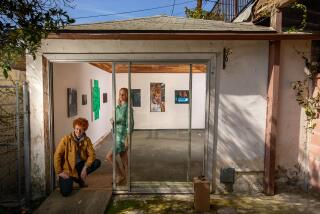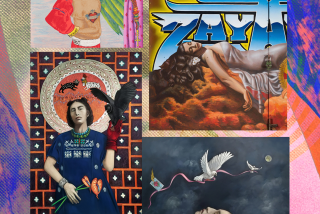Kicking in for art projects
- Share via
When Los Angeles performer Selene Luna applied for a grant in 2007 through the Franklin Furnace Fund, it took nine months and packets of paperwork to receive her money — a small bounty of $3,000.
But last month, looking for financing for her online soap opera, “Selene’s Hollywood Confidential,” she turned to a less traditional fundraising source: Kickstarter.com. It took her 30 days to meet her $5,000 goal. In fact, she even raised a little more.
Luna is one many Los Angeles artists who have turned to Kickstarter.com, an interactive fundraising site that taps into an artist’s online social media network. Started in April 2009, the site raises an average of $2 million per month in donations and boasts more than 300,000 users, according to co-founder Yancey Strickler. In Los Angeles alone, Strickler said, 800 projects have been funded, raising nearly $2 million for local works.
Each Kickstarter project includes a pitch — usually with a video, an update page and a list of the backers. Hanging over all the Kickstarter projects is a countdown set to a self-imposed deadline.
The easy integration with Twitter, Facebook and e-mail allows artists to ask for money in a way that doesn’t feel like begging, encouraging contributions large and small. Most of the donations to Luna’s project came in denominations of $10 and $20.
“We are in the Depression right now,” said Luna, a burlesque and cabaret comedic actress who frequently performs in Silver Lake and Echo Park clubs and who also happens to be 3 feet 10 inches tall. “Even asking for five grand was ambitious.”
Luna’s project is a semiautobiographical online soap that sheds light on the absurdity of her day-to-day existence on the fringes of show business, a light-hearted comedy that might be too edgy to nab mainstream financing — and too whimsical to garner funding from a serious arts organization.
And those funds are more scarce than ever. “The trend across the board is that foundation support is significantly down, endowments are down, corporate support is significantly down and government support has also eroded slightly,” said Laura Zucker, executive director of the Los Angeles County Arts Commission.
Angela Han, the director of research for the National Assembly of State Arts Agencies, said that California ranked dead last in terms of per capita funding for the fiscal year ending June 2010. “Their appropriation of $4.1 million works out to 12 cents per capita, much lower than the national average of 99 cents.”
Zucker said that something like Kickstarter can only be a boon. “I think anything that helps connect people to the creation of new work is a great idea.”
It’s not just fringe artists using Kickstarter. Hollywood actress Lake Bell, who stars in HBO’s “How to Make It in America,” turned to the site to raise money for post-production fees on the short film “Worst Enemy,” her first writing and directing project, starring “Saturday Night Live” cast member Michaela Watkins. The short — about a woman who becomes trapped in a bodice she bought off a late-night infomercial — met its $8,000 Kickstarter goal, and had already surpassed it well before last Thursday’s deadline.
Although it didn’t hurt that Ashton Kutcher tweeted about the project to his 5.8 million followers, Bell says her project was funded not by random strangers but by her own family and friends (a group that included Eva Longoria Parker and Jeff Garlin of “Curb Your Enthusiasm”).
“It’s like getting your friends to be a part of a project without saying, ‘Hey, can you fund half of it?’” said Bell. “You’re part of a community. It doesn’t feel desperate to me. It feels innovative.”
For many artists, Kickstarter simplifies the otherwise complicated process of fundraising. Luna said many of her peers never took advantage of traditional grants: “A lot of artists who are profoundly talented don’t have it in them to take care of business.” Kickstarter, she noted, “is less daunting.”
But, she cautioned, “you gotta work for it.” Luna believes she won over supporters by posting a complete list of her budget needs; she researched other similar, successful projects, and had the benefit of a few thousand “friends” on Facebook.
Kickstarter, as well as other similar fundraising sites like Spot.us and Indiegogo, has pulled back the curtains from the philanthropic process. That transparency “gets more people invested in the project,” said Bettina Korek of the Los Angeles organization ForYourArt, a company that connects patrons to artists. And it enables patrons to spread the word to their friends via their own Twitter or Facebook pages.
The thought of asking for money so publicly initially gave Casey Spooner, the singer of cult band Fischerspooner, pause. “I was like, people are going to think, ‘What happened to this dude, he’s totally washed up,’” said the singer, who started his career 10 years ago with a million-dollar record advance. “Everyone still thinks I’m rich,” he said.
Spooner needed money to go on tour with the Scissor Sisters, who played L.A. in September. He raised more than $10,000 in less than three weeks. “I had feared humiliation,” he said, “but in the end it ended up being really invigorating and people were super supportive.”
But it also means that the world can see you fail. Michelle Carr, who founded the L.A. burlesque troupe Velvet Hammer, failed to raise the $10,000 she needed to fund a multimedia dance project about Weimar-era German expressionist dancer Anita Berber.
“What was I going to lose from trying, except maybe a little bit of my pride?” Carr said with a flash of self-deprecating humor. Perhaps it didn’t help that Carr and Luna’s projects were posted around the same time, and that the two women’s local audiences overlap. “There are only so many projects people can afford to donate to. a small pool.”
Still, Kickstarter’s model is so deceptively simple and appealing that the more traditional art world is entering the fray: Project Site, which is in its alpha phase, features grant recipients handpicked by United States Artists, a grant-making and artist advocacy organization. It bears an uncanny resemblance to Kickstarter, right down to the project goal counter.
Unlike Project Site, Kickstarter’s curation is minimal. Though they highlight projects on their front page, applications are rejected mostly because they are “noncreative projects,” said Strickler.
The range of work on the site can be overwhelming, such as Farhad Parsa’s long-term photography project documenting New Yorkers in their homes, the serialized novel “Cocky the Fox” and Los Angeles native Jessica Leung’s gritty documentary “In a Strange Land,” made with her husband, Paco Beltrán.
“I do feel that the next phase of this will be when we value the experts again,” said Korek. “I would quite frankly rather support something that a team of curators suggest to me, because I don’t have the time to go through Kickstarter.”
But the art-for-art’s-sake nature of Kickstarter thrills Korek, who notes that these are not artists looking for profit: “They want to realize their work.”
After wanting to make her project for two years, Luna finally filmed the theatrical portion of the video. And Bell just wrapped shooting on her short movie.
“I’m looking forward to the next step,” said Bell, which she hopes is the film festival circuit. “It’s life-changing stuff. Like, ‘Wow. Dream just came true.’”
More to Read
The biggest entertainment stories
Get our big stories about Hollywood, film, television, music, arts, culture and more right in your inbox as soon as they publish.
You may occasionally receive promotional content from the Los Angeles Times.










